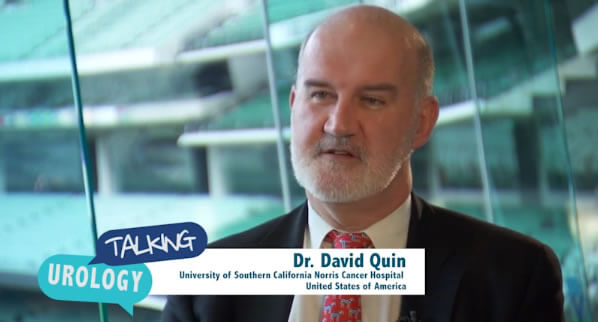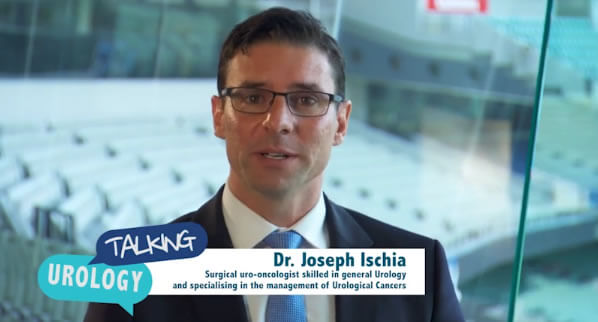In this ANZUP conference highlight, Andrew Weickhardt chats with Betsy Plimack, Chief of the Division of Genitourinary Medical Oncology, Fox Chase Cancer Centre in the US. She talks about the future potential role of genetic mutations in urothelial cancer: can they predict response to treatments or even decide which treatments you should use? They also discuss the use of the new immuno-oncology agents in metastatic kidney cancer: what are the second line options, and how do we measure success of treatments- keep a close ear out for the emerging concept of treatment free survival as the yard stick for the immune-oncology agents.
Elizabeth Plimack is an associate professor of Medical Oncology, Chief of the Division of Genitourinary Medical Oncology & Director of Genitourinary Clinical Research at Fox Chase Cancer Centre, USA. Dr Plimack has extensive clinical trial experience with immunotherapies and novel combination therapies. She serves on the national Comprehensive Cancer Network guidelines panels for bladder, kidney & prostate cancer, the Bladder Cancer Avocacy Network Management and Think Tank Steering Committees, and on the American Joint Committee on Cancer (AJCC) Urinary Tract Expert Panel.
Talking Urology podcast transcript
ANZUP 2019 Interviews – A/Prof Andrew Weickhardt and A/Prof Elizabeth “Betsy” Plimack
Andrew Weickhardt: I’m Andrew Weickhardt, medical oncologist, and I’m delighted to be here today with Elizabeth Plimack, medical oncologist, from Fox Chase in Philadelphia. She’s been here at ANZUP talking with us about bladder cancer and kidney cancer. Betsy thanks for coming.
Betsy: Thanks for having me.
Andrew: So, bladder cancer, you’ve spoken to us about your collaborations that led you to make some discoveries about how to treat bladder cancer. Can you let us know what the key points of that talk was?
Betsy: Sure. So, part of the message from this meeting is making connections which I love because I think the field is moving away from individual science towards large group collaborations. And so, part of the story I told was how our group came together with Jonathan Rosenberg in L.A. and Elie Van Allen’s group and others and sort of snowballed into bigger projects, greater ideas, more sharing of information, sharing of samples that led to ultimately a stronger outcome.
I think the story we’re trying to tell together is that DNA repair, damage, alterations in bladder cancer specimens prior to TURBT or at TURBT prior to neoadjuvant chemotherapy predict or can be a powerful tool to predict response to chemotherapy. And so, higher-level validation is required. But all of our findings together and separately have led toward that conclusion. And so, we hope to be able to advance that further through analysis of samples and randomized trials.
Andrew: So those mutations and genetic defects, what are they and are they ready for prime time for me to choose which patients should be given neoadjuvant chemotherapy?
Betsy: So, that’s a good question and there’s no straightforward answer to either. So, what are they? They are DNA damage alterations in tumor tissue is what they are. Various groups have defined them differently. Memorial has a clinical trial that hinges on a list from the literature. We have a clinical trial that hinges on the four that we validated together ATM, RB1, FANCC and ERCC2, but both those trials are looking to predict patients who have exquisite sensitivity to neoadjuvant chemotherapy and then as part of a clinical trial keep their bladder. So, primetime no in the clinic, but we are leveraging these findings to develop trials for bladder sparing.
Andrew: So, neoadjuvant chemotherapy. It’s a topic where the literature will show is a benefit in delivering new adjuvant chemotherapy but there’s some heterogeneous practice out there.
Betsy: Yes, yes.
Andrew: What are the barriers in your setting to delivering neoadjuvant chemotherapy?
Betsy: So, in our setting, there are very few because we’ve worked together so closely with urology, it’s part of our practice, we’ve done research in the area. But in talking to folks in the community and internationally it’s an extra step. It’s kind of easier to just sort of go straight to surgery. Chemotherapy is not fun. It is thought of as toxic and for many patients it is. And so, I think these barriers have in the past really precluded patients from getting this I think lately in the data that’s been shown observationally at least in the United States over time, is that uptake has been more robust as of late. But it’s still one of those things that takes a special patient to make it through all of that and some patients just can’t.
Andrew: So, you and I share something in common.
Betsy: Yes.
Andrew: So, can you talk me through what the advantages are compared to delivering Cisplatin and Gemcitabine?
Betsy: So, a couple of advantages that we see. One is our data use three cycles. We’re done with chemotherapy in six weeks. It really meshes nicely with the OR scheduling, so a patient can be seen for a cystectomy, plan for the OR, we can just kind of squeeze that chemotherapy in there. The toxicity data that’s been published has been really on par with retrospective data sets of GemCis. And the study that I’m really looking to, to see how the toxicity differs is the COXEN trial that recently completed, that biomarker data was reported by Tom Flaig at ASCO. But we really want to see toxicity data. The efficacy was similar which we sort of knew and suspected, but quicker, less toxic has been our experience.
Andrew: Fantastic. So, let’s pivot to kidney cancer. You’re involved in many early Phase 1-2 trials of combination therapies.
Betsy: Yes.
Andrew: And nowadays treating kidney cancer, there are exciting combinations that are based on some of that work.
Betsy: Yes.
Andrew: Can you talk us through the key points from the talk you gave this morning about which way the field’s moving?
Betsy: Right. So, I think the field is definitely moving towards combination with a base of immunotherapy. So Axitinib and Pembrolizumab or Ipilimumab and Nivolumab are the two that sort of rises to the top based on the overall survival data and the randomized trials. I think the issue then that happens is what do you do after those therapies and we don’t have good trials looking at that. I’ll present in my next talk an intergroup trial on the PEDIGREE trial coming out of Duke group of investigators through the intergroup that is seeking to parse that, but it will be difficult because there’s so many downstream options.
Andrew: So, the recent data coming from those two large trials Ipi/Nivo and the Pembro with either Axitinib or Avelumab with Axitinib was really interesting in that it showed that response rates could increase and you showed that two out of three of those studies have reported improved overall survival.
Betsy: Right.
Andrew: So, here’s my question, which patient at the moment in 2019 should not receive immunotherapy in first line treatment?
Betsy: Right. So, I think there are probably a subset of those patients. I don’t know that we have defined them well, but they tend to be favorable risk. Generally, in my experience defined as the indolent growth pattern, which is part of the favorable risk definition. Dave McDermott and colleagues published some very interesting gene expression data suggesting there may be a biomarker of benefit to angiogenesis therapy coming out of the Atazovab versus Sunitinib study. So, I think we’re kind of closing in on a definition both biologically and clinically of the type of patient who may not need I-O upfront or may never benefit from I-O. That second question I think is a lot more diffuse and unknown, but I think we’ll get there and there probably will be a set of patients defined who can get away with low-dose, single-agent VEGF TKI.
Andrew: So, complete response rates 9 percent in Ipi/Nivo and and if you firmly believe in I-O/I-O, you cling to the durable long term, the complete response rate and at being slightly less is 6% in the Pembro/Axitinib data. Do you believe that that’s a really important figure that we should base our treatment decisions on in patients with intermediate and poor prognostic?
Betsy: I’m so glad you asked me that question because what I like to emphasize is that CR is a construct of the resist way of measuring tumour volume and response. We have all had patients who are PRs, but when we go to resect what’s left, it’s scar. So, there are certainly PRs who are probably cured by treatment and there are CRs who then later recur. So, that figure is not what I would look to. What I would look to is Dave McDermott’s data on treatment-free survival. I think that’s more relevant. How can we get patients to a place where their disease is treated such that they don’t need subsequent therapy and are still alive and doing well? That is not measured by CR, PFS or OS, it’s sort of its own saying and looking at that in the long term for all these studies is going to be critical.
Andrew: Right. So, in terms of patient walks in, intermediate prognosis, tomorrow in clinic, are you an Ipi/Nivo or a TKI/I-O kind of person or does that vary with your discussion with the patient?
Betsy: I am Axi/Pembro person based on the overall survival data and based on the fact that it seems to cross different groups more reliably. I also believe in that combination because of our prior experience with Nivolumab with Sunitinib where we have a collection of those patients in our clinic doing beautifully, so even though we haven’t seen the long-term data on that combination from the Phase 3, we have some from the Phase 1/2 that looks very good, 87% of patients alive at two years. I mean, that’s pretty impressive and leaning on that older data, I do believe we’re going to see long term durable responses and benefit to that combination, so that’s my go to right now as of today.
Andrew: Fantastic. And we’ll finish with one further question then. Just managing side effects of immune toxicity and the I-O/I-O combination has its own range of side effects, do you find that it difficult to manage for yourself now that you’re familiar with that sort of pattern of side effects? Do you still get stumped or now are you sort of familiar enough with colitis that it’s like a reflex to treat?
Betsy: It’s always disappointing when someone get these autoimmune events. It’s always almost always the hospitalization. I will say in the early days, it was also this racking your brain through all your internal medicine knowledge looking for what could be autoimmune versus what could be something else and that part has become more straightforward. It’s a little more definitive to me when I see it whether it’s immune related or not. A lot of people will ask with the VEGF I-O combinations diarrhea, how do you determine it? The answer to that is you hold both drugs. If it goes away after three days it’s the Axitinib, and if it doesn’t, then start steroids and some Pembrolizumab. These kinds of things are things that have evolved over time, but there is definitely an expertise that comes with it not just from medical ecology but for everyone in the hospital that cares for these patients across the disciplines.
Andrew: Yes. Well, thank you so much for joining with us today and sharing your expertise both at the conference and in these sort of chats. It’s been fantastic having you here in Australia.
Betsy: Absolutely. Thanks for having me. It’s been great.
Andrew: Fantastic.










